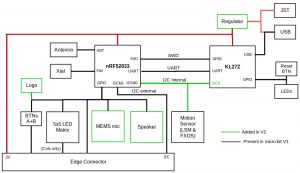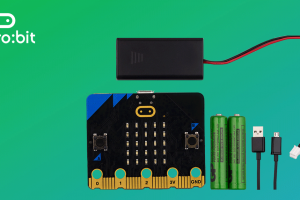
micro:bit v2 is built around a Nordic Semi nRF52833, which will run application code, Bluetooth stack and handle USB. The core in this chip is a 64MHz Arm Cortex-M4 with a floating point unit – described as “the CPU power to run AI and Machine Learning workloads”, by the Micro:bit Educational Foundation.
This differs from the original, which uses a Nordic nRF51822 (Cortex-M0) for applications and Bluetooth, and a separate Freescale Kinetis KL26(Cortex-M0+) to run USB.
On the subject if AI: “Within days of getting a device, Gordon Williams, lead developer of Espruino had the micro:bit supported in their on-line platform,” according to the Foundation. “This allowed JavaScript programs to run on the device, including Espruino’s gesture recognition libraries that were originally designed for bangle.js and use Tensorflow Lite.”
micro:bit v2 compared with micro:bit v1.5
In another demonstration, each member of the micro:bit team was recorded saying “micro:bit” three times, then the Edge Impulse cloud service was used to create a model that could recognise the word ‘micro:bit’ being said.
“With so much speculation and often misunderstanding about the possibilities, risks and complexities of AI and machine learning,” said the Foundation, “we believe that the micro:bit device can bring the same transformative simplicity to the teaching of these concepts that it brought to physical computing and computational thinking.”
A collaboration with universities, industry, schools and makers is underway to develop further AI and ML capabilities for the new micro:bit.
Bluetooth 5
With the Nordic nRF52 on micro:bit v2 comes Bluetooth 5.1 and Bluetooth features including: 2MHz links, advertising extensions, long range and 5.1 direction-finding.
 As with 1.x variants of micro:bit, the Bluetooth transceiver also supports the simple ‘microbit-radio’ protocol small-packet broadcast radio interface to other micro:bits.
As with 1.x variants of micro:bit, the Bluetooth transceiver also supports the simple ‘microbit-radio’ protocol small-packet broadcast radio interface to other micro:bits.
New features elsewhere on the PCB include a mini loudspeaker (operating in parallel with the audio out connector), to go along with an on-board MEMS microphone.
Then in addition to the two front tact-style user buttons (and the rear reset button), the front double-dot logo is now a capacitive touch sensor.
Coding
Coding has changed a little as the two generation of application/Bluetooth processors differ.
 “The latest micro:bit supports a new kind of hex. We’re calling it ‘universal hex’: this contains the machine code for both versions of the micro:bit,” said the foundation. “The latest micro:bit is able to choose which code it should use from the universal hex. The files are designed so the original micro:bits do not need any update to use them.”
“The latest micro:bit supports a new kind of hex. We’re calling it ‘universal hex’: this contains the machine code for both versions of the micro:bit,” said the foundation. “The latest micro:bit is able to choose which code it should use from the universal hex. The files are designed so the original micro:bits do not need any update to use them.”
Arm, Lancaster University and Microsoft, companies in at the birth of the original micro:bit have worked together on a compatibility layer for microbit-dal that allow existing projects and environments to be recompiled to work on the latest board, and added features like an advanced SoundExpressions synthesiser and audio pipeline architecture to go with the new hardware.
 MakeCode, MicroPython and Scratch are using CODAL to support the new device. “We recommend that anyone building software to run on the micro:bit do the same to ensure consistent experience across micro:bit editors,” said the Foundation. “This will also ensure that as new features get added they can be incorporated easily and made available to users – it’s easy to forget that micro:bit radio wasn’t in the original micro:bit release.”
MakeCode, MicroPython and Scratch are using CODAL to support the new device. “We recommend that anyone building software to run on the micro:bit do the same to ensure consistent experience across micro:bit editors,” said the Foundation. “This will also ensure that as new features get added they can be incorporated easily and made available to users – it’s easy to forget that micro:bit radio wasn’t in the original micro:bit release.”
Power
Compared with Raspberry Pi, micro:bit has far less processing power, but also consumes far less electrical power, allowing regular operation from batteries.
With version 2 comes a built-in sleep mode that aloes the board to remain connected to a battery, and a discrete regulator that can supply up to 190mA to external accessories.
Farnell is the exclusive global manufacturer of the micro:bit, including the v2, through its Embest business in the Far East.
micro:bit v2 should be available next month. Before then, details can be found on this web page.
 Electronics Weekly Electronics Design & Components Tech News
Electronics Weekly Electronics Design & Components Tech News



